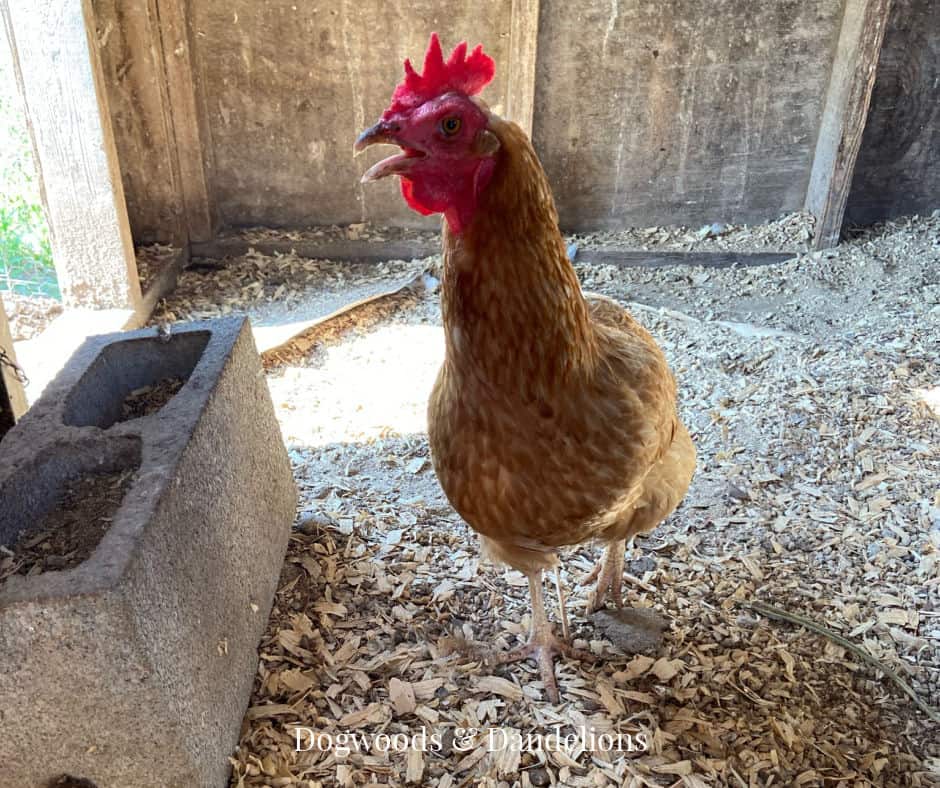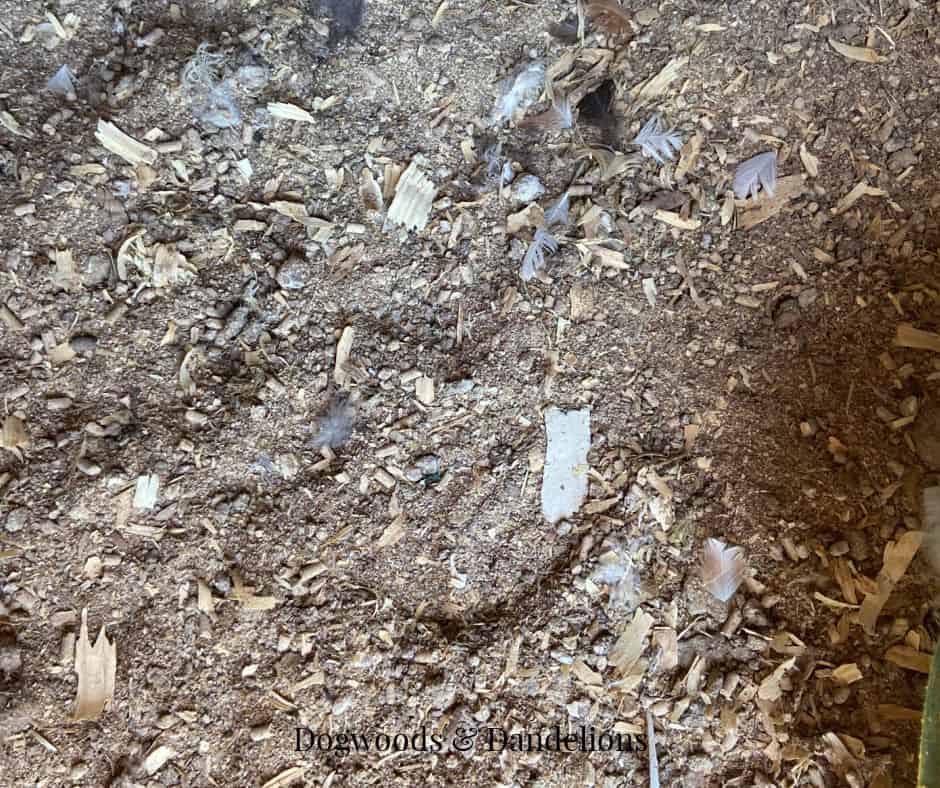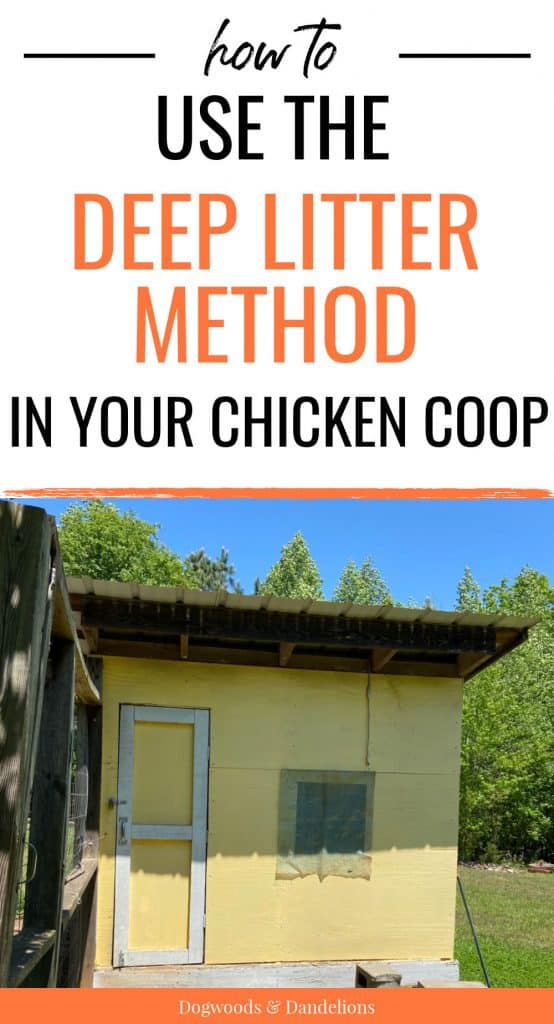Using the Deep Litter Method in Your Chicken Coop
Inside: Learn how to use the deep litter method in your chicken coop and why it can be an easy way to manage the poop in the coop.
While there are many ways to maintain your chicken coop, using the deep litter method with chickens is probably the simplest way to deal with poop in the coop. Learn the advantages (and the disadvantages) of using the deep litter method in your chicken coop.
What is the Deep Litter Method?
First, we need to understand what the deep litter method of coop management is. The deep litter method uses a carbon-based material (litter) to absorb moisture and odor from chicken feces. As the litter breaks down, new litter is added on top of the existing litter to maintain a dry coop.
Advantages of Using the Deep Litter Method with Chickens
Using the deep litter method of coop management has many advantages.
The major advantage is that there is less cleaning of the chicken coop. You don’t have to clean your coop daily or even weekly. A once or twice a year clean-out is all that is necessary.

Affiliate Disclosure: Please note that some of the links in this article may be affiliate links and I may receive a small commission if you purchase something through a link. It will not change your cost. As an Amazon Associate, I earn from qualifying purchases. For more information, see my disclosures page.)
A second advantage is that you get free compost. As the chicken poop decomposes with the bedding, it creates a rich source of nutrients for your garden.
Thirdly, the deep litter method can provide additional heat for your flock during the winter. As the material is decomposing, it creates heat just like a compost pile. (And actually, your coop floor IS a compost pile.)
As the litter decomposes, it also attracts microbes that are beneficial to your chickens, much like probiotics are beneficial to us. This can help prevent diseases in your flock.
Another benefit to the deep litter method is that it provides your chickens with something to do, especially if they can’t be let out to free range. Digging and scratching through the litter will provide your flock some entertainment and keep them from picking on each other.
And if properly managed, the deep litter method will keep your coop odor free.
How to Use the Deep Litter Method with Chickens
Using the deep litter method with chickens is easy. First, put 3 – 6″ of bedding (litter) in the coop over the floor. You have many choices for bedding including dried grass clippings, leaves, hay, straw, or pine shavings.
I prefer pine shavings for their ability to absorb odors easily. Don’t use cedar shavings as they aren’t good for your flock’s respiratory system.
At least once a week turn the bedding and add a fresh layer if needed. If you don’t want to turn the bedding yourself, throw a handful of scratch on top. Your chickens will gladly turn it for you hunting the scratch.
Each week, add additional litter to help absorb odors and wetness. If at any time you smell ammonia or the bedding becomes saturated, add additional litter or remove it and start over.
Be sure your coop has adequate ventilation. Your chicken coop should not be air tight.
However, you don’t want to cause drafts on the roosts at night either. The easiest way to provide ventilation is to have small openings near the top of the coop that are covered with hardware cloth.
When to Clean Your Chicken Coop
One of the major advantages to using the deep litter method with chickens is that you don’t have to clean your coop as often. Notice I didn’t say NEVER.
But generally, if you are properly maintaining the litter, cleaning the coop once or twice a year should be sufficient.
The best time to clean your coop is in the spring. You can also do a second cleaning in the fall if you prefer. To clean your coop, remove all the old bedding and scrub the coop.
Read: How to Clean a Chicken Coop
If you plan to use the deep litter method again, you can add a layer (1-2 inches) of the old litter back to the coop after it is cleaned. This will actually jump-start the decomposition of the poop and return some of those beneficial microbes to the litter.
Of course, after cleaning, add 3 – 4 inches of your preferred bedding back to the coop.
What to Do With the Chicken Poop

Once you have cleaned your chicken coop, you can use the litter in your garden. The deep litter method is basically just a compost pile in your coop.
While some experts say you can apply the litter to the garden immediately, I prefer to wait at least 3 months before using it in the garden.
Chicken manure is very high in nitrogen and can burn your plants if it hasn’t decomposed sufficiently. I always prefer to err on the safe side and wait to add it to my garden.
Don’t Do These Things if You Use the Deep Litter Method
Don’t clean your coop regularly if you are using the deep litter method. Otherwise, you are removing all the beneficial microbes that break down the chicken poop. Twice a year is often enough.
Don’t use Diatomaceous Earth (DE) in your coop when using the deep litter method. DE is the fossilized skeletons of small aquatic organisms. It is often used to prevent mites in chickens. However, it will destroy all the good microbes too.
Don’t use the deep litter method with baby chicks. They need to be kept in a clean brooder area and all too often they spill water and food that will cause the bedding to mold.
A Few Precautions
- Be sure your coop is well-ventilated.
- The bedding should never be wet.
- If at any time, you see mold, remove all the bedding, thoroughly clean the coop, and start over. If wet bedding is happening regularly, you aren’t providing enough litter to keep it dry. Add more litter or choose another method of coop maintenance.
Is the Deep Litter Method Right For Me?
The deep litter method is definitely not for everyone. If you have a small coop with 3 or 4 hens, it’s probably easiest to clean the coop once a week or so.
Even if you have a large coop but a small flock, you will probably want to use another method. With only a few chickens in a large area, you may not have sufficient poop to get the microbes working.
The deep litter method is not suitable for use with a chicken tractor that you move around the yard. You should be moving the tractor regularly so poop doesn’t accumulate anywhere.
If you keep your waterers inside the coop and your flock frequently knocks them over, this is not a good method for you. Leaving wet litter in the coop will cause mold that can be deadly to your chickens.
Hopefully, the information provided in this post will help you make a decision about whether the deep litter method with chickens is right for you!
Related Posts
- What do you need when building your chicken coop?
- How to Control Flies in the Chicken Coop
- How Many Chickens Do You Need?

Meet Julie
I’m a farm girl born and bred in North Carolina. I’ve been growing a vegetable garden for over 20 years (and helping my Mom grow hers even longer). I’ve been raising chickens in my bathtub and backyard for 12+ years. I believe that homegrown food can be made simple. Let’s get started.


